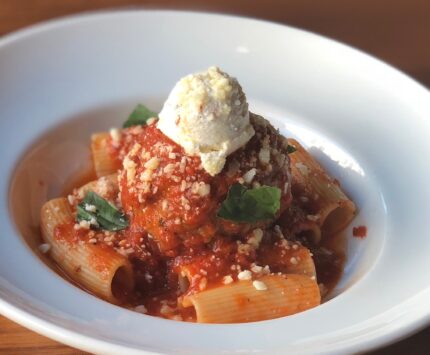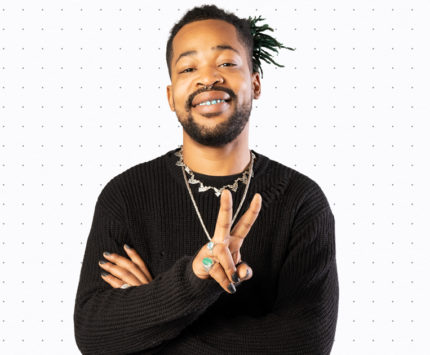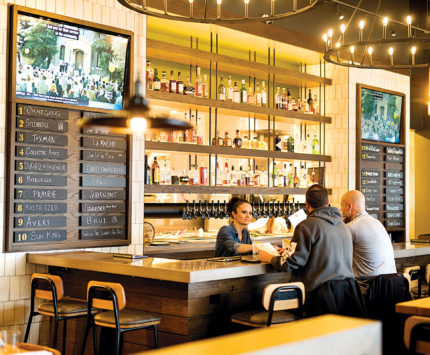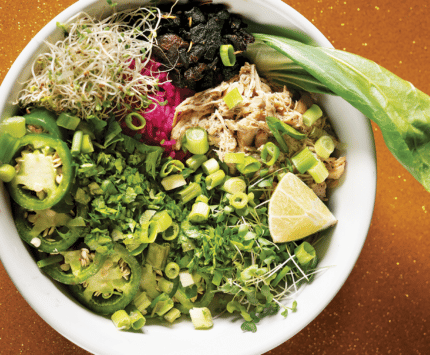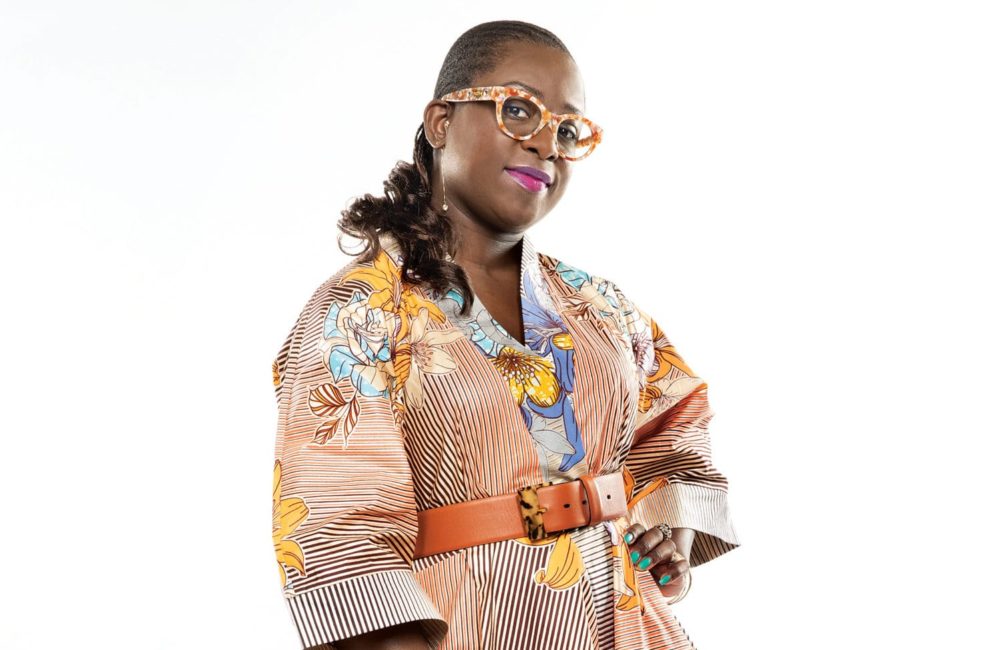
What Are You Wearing — And Why Isn’t It Made In Indy?
A Pattern Magazine launch party can feel otherworldly, as if fearlessly fashionable people from The Sartorialist’s Instagram account came to Indy through a secret portal. In October 2019, the last one before the pandemic shut them down, about 250 people gathered in what was billed as a “super-secret” commercial loft space on New York Street downtown. A Realtor paired a red faux-fur chubby coat with Beatle boots. A well-known papel picado artist wore a dark menswear-inspired suit, accessorized with a diamond-patterned tie and a colorful, glittery long scarf, along with John Lennon iridescent glasses. A fashion designer danced in a gunmetal jumpsuit with her own gold-trimmed, black-brocade military-style jacket. There were elegant LBDs and The Weeknd–inspired suits, fascinators and ball caps, and a Def Leppard vintage concert tee paired with large, gold hoop earrings and a top knot.
They entered under disco balls and colorful LED strands hung from the ceiling by local artist duo Owens + Crawley to shower them in “little starbursts of light” and roamed two darkened floors of immersive mystique. Artist April Knauber handed out pieces of gum for people to chew and stick to an antique school desk as a contribution to her installation Blow Me. Artist Bruce Loewenthal asked observers to close their eyes, touch vintage clothing on a rack, and “wander into a forest of memories.” Over there, Alkemy freestyle dancers. The other way, former Indianapolis Mayor Greg Ballard holding the magazine for a photo with editor-in-chief Polina Osherov wearing cat ears. Somewhere else, stacks of retro TVs with graphics on the monitors and a vintage red chair for an artful pose.
But this was no crowd imported from the coasts. It was all Indy, thoroughly original, and light on both the tedium of the step-and-repeat aesthetic of influencers and Real Housewives drama. The most tense moment came when a woman tossed her vintage clutch at another woman who was flirting “intensively” with her boyfriend. A social media report was later filed. The bag, ultimately, was fine.
“Every Pattern party I’ve attended feels like I’ve been transported to a more fashion-forward city, but with much cooler and far less pretentious people,” says Leslie Bailey, a member of the Indianapolis Fashion Collective that morphed into Pattern (a nonprofit that publishes the magazine) in 2010. That night, as the 37-year-old CEO of Indy Maven stood in line to get her portrait sketched by Indy illustrator Ken Avidor, she looked around and wondered, How have all these well-dressed, interesting creatives been hiding in plain sight?
Is this locally designed fashion right under our noses, too?
***
Play a game of Indianapolis word association and “creative fashion scene” likely wouldn’t make the cut. While Indiana has produced distinctly stylish humans—from Columbus’s Stephen Sprouse, who gave Blondie’s Debbie Harry her New Wave look in the 1970s, to Zionsville’s Grace Hartzel, a steely-eyed model who starred in Vogue’s fall 2020 collection video—the state’s capital city doesn’t yet have a defined fashion aesthetic—say, like Detroit, where creatives describe their style as being grounded in the city’s music and manufacturing heritage. Nor does it have hip, world-famous Motor City brands like Shinola, which just opened a hotel, or Carhartt, the iconic American workwear now being co-opted by beanie-wearing Instagram influencers.
But over the past decade, a growing number of niche clothing designers, economic development organizations, and other style-minded residents have begun building a credible, emerging fashion ecosystem in Indianapolis. Like the semi-mysterious locations of Pattern parties, this network can seem like a secret to consumers interested in buying local fashion.
“It’s not a community that’s super easy to find,” admits Osherov, who cofounded Pattern in 2010 as a growth accelerator for creatives (the fashion magazine followed in 2012). “But once you slice into the veins of what could be considered the local fashion scene or industry, you can pull yourself into it and find out who all the key players are.”
Some have made national, and even international, names for themselves on red carpets and runways. Tailor Jerry Lee Atwood first caught high-level red-carpet attention after designing the bedazzled emerald green suit that rapper Post Malone wore to the 2019 Grammys, looking like what Vogue described as a “modern-day Elvis.” Nikki Blaine, who this year will mark 10 years of owning Nikki Blaine Couture in Zionsville, presented her glam-chic The Queen of the Night collection at Paris Fashion Week in 2019 and has designs featured in the Flying Solo showroom in New York City. Models outfitted in edgy patterns and classic silhouettes by Barbara Riordan, of the local label Pariah, strutted the runways at Vancouver Fashion Week in 2018; a year later, Vogue UK gave her a write-up in its “Big Fashion Issue.”
No centralized data sorts out the number of working fashion designers
in Indianapolis, though. The Indiana Fashion Foundation is working on collecting and expanding local stats, says CEO Denisha Ferguson. The nonprofit has a list of 78 mostly part-time fashion and accessory designers in the state, two-thirds of whom reside in Indy. Indy Chamber’s data gauges it a bit higher. In 2019, the inaugural Indiana Fashion Week, an industry convention, attracted 15 designers and nearly 900 attendees. In 2018, Pattern started working with St’ArtUp 317, a Develop Indy–led art and retail pop-up program that encourages the owners of vacant or under-used commercial space to take risks on local talent and young brands. Osherov estimates they’ve since created 100 free pop-up opportunities for small-business owners and creatives, including fashion designers.

Denisha Ferguson, president of the Indiana Fashion Foundation and a designer herself, oversees StitchWorks, Indy’s first cut-and-sew facility. It helps designers find sewers, pattern-makers, and other key resources.
But pairing these working local designers with your closet takes some stitchwork. You won’t see them on billboards as you drive to the Fashion Mall. And because the designers are working independently on custom pieces or small-batch collections, they’re not represented in local, well-known brick-and-mortar boutiques. Nor do they necessarily aspire to be.
“For me, it’s been super organic, and that’s the way I wanted to push the brand,” says First Impression Clothing’s Briana Davis, a 27-year-old self-taught streetwear designer selected to apprentice this month at Nike headquarters as part of a team designing Serena Williams’s 2022 tennis collection. Davis has also designed a floral bomber jacket worn by Purdue soccer player and Olympic medalist Lauren Sesselmann, and, at rapper Kevin Gates’s request, a pair of custom knee patches for jeans he already owned. “With my work being so artistic and handmade, and it being a passion of mine, I didn’t want to treat it like something that’s easily accessible.”
Like Davis, most of these up-and-coming designers are discoverable via niche media or social media, word of mouth, or live events. Following IndyDressed blogger Sarah Byrne takes you to Jenn Felts, aka Tokyo Twiggy, who posts bold, Japanese-inspired sketches of T-shirts, dresses, and swimwear on Instagram and accepts inquiries via DM. A conversation with Ferguson of the Indiana Fashion Foundation leads you to Macy Knight, who sculpts explosions of tulle into eye-catching dresses for young women who have zero desire to blend in at prom or other special events. Jennifer Magley, a former standout NCAA athlete turned author and motivational speaker, found William Tyler Grube in 2017 when she put out a call on Facebook, looking for someone to make disco-era shirts for her kids for a themed holiday card. He has since designed her wedding dress.
In February, Kaylee Williamson, a 25-year-old wardrobe stylist who owns online shop Beautiful Flyaway Vintage, spotted Shuë Clothing Co. at Muses in a Mansion, a fashion networking and content-creator event, in early 2021 in Indianapolis. The local streetwear brand was a clothing sponsor of one of the events, where the hosts provide a luxury shooting location and camera-ready models in different cities. Williamson started following Shuë on Instagram and bought a tan chest rig for future editorial shoots. Once a utilitarian item for carrying gear, the rig has become a distinctive accessory. “I just really wanted to use one of their pieces for a shoot,” says Williamson, who recently styled a winter feature for Aperture, a New York-based photography journal. “They’re different and edgier than most things I’ve seen in Indy.”
***
In 2016, Tiffany Benedict Browne, known for her blog Historic Indianapolis, was browsing Etsy for examples of her enduring obsession: clothing designed with Ankara, a high-quality, versatile fabric in bold, colorful prints. One day, she stumbled across photos of models wearing Ankara designs while posing in front of the Indiana Statehouse. “I thought, Wait, what? This person is in Indianapolis?” says the 48-year-old. “I wrote to her right away.”
Browne met with Stylenspire founder Yemisi Sanni and eventually commissioned the Nigerian-born 39-year-old
to create a vivid maxi dress for the 2017 Zoobilation. Now Browne owns 11 skirts and four dresses by Sanni.
Sanni grew up in a family of 10 children in Lagos and is a native of the Yoruba tribe, an ethnic group in western Africa known for its strong artisanal traditions. As a teenager, she could reproduce garments just by looking at photographs. In 2006, she moved to Indy after visiting her older sisters who attended Indiana University. Two years after launching her Stylenspire blog in 2013, she started making waves as a designer at Midwest Fashion Week.
“I almost consider myself a Hoosier because I found myself here,” says Sanni, whose Afro-contemporary clothing designs, while inspired by her Yoruba heritage, carry “Made in Indianapolis” labels.“Being in Indy helped me develop into the woman I really wanted to be.”
In 2015, Sanni created the beautiful “Heritage Dress” for Project IMA: Cutting Loose, the wildly inventive Indianapolis Museum of Art runway show that hosted new and established designers, and won the Audience Choice Award. She spent four months making the garment, importing fabric from Nigeria and lace from the United Kingdom. (Sanni travels to Nigeria to source fabric or enlists her mother or best friend to ship it to her.) The Indiana State Museum displayed the dress at its 2019 Color of Style exhibition, and later acquired it for its permanent collection. Sanni designed the “Heritage Dress” to highlight the positive contributions that immigrants make to their adopted homelands.
“It’s just striking,” says Meghan Smith, a conservation laboratory manager who curated the exhibition. “The unconventional, pointed, four-corner hem was so fascinating to me, the not-quite-red, not-quite-fuchsia color and other accents were bold but not overpowering, and I loved the upper silhouette that had almost a racerback look. In the gallery, it looked beautiful.”
Custom designs from Sanni can be pricey, ranging from $250 to $3,000. But if you’re the person who values one timeless piece more than 30 shipped from Brandy Melville, then it’s worth it. Sanni’s work represents a broader, local designer-led movement toward “slow fashion,” and even sustainable textile-making as well. In Bloomington, Rowland and Chinami Ricketts grow and harvest indigo on their farm, hand-dyeing fabric that Chinami hand-weaves into scarves or kimonos, and that Rowland uses to create immersive art installations, such as Ai no Keshiki—Indigo Views, featured through mid-August in the Renwick Gallery, a Washington, D.C., branch of the Smithsonian American Art Museum. The meaningful stories woven into this type of work appeal to a subset of consumers who care about the integrity of materials and processes and who want to reflect a sense of place or their ethnic and cultural heritage.

Polina Osherov has run Pattern since 2010. The nonprofit’s high-fashion magazine, sold in seven countries, has brought visibility to Indy’s fashion designers, such as Jerry Lee Atwood.Photos courtesy Polina Osherov
“Buying custom or small-batch clothing is like investing in art,” says Petra Slinkard, who helped shape exhibitions such as An American Legacy: Norell, Blass, Halston and Sprouse at the IMA, and who is now curator of fashion and textiles at the Peabody Essex Museum in Massachusetts. “You’re investing in a person’s work, but also in an idea and an ethos that can represent more than just a brand, but the DNA of a region.”
Growing up, Grube remembers when his grandmother, a skilled seamstress, would browse Dillard’s for inspiration, then cut up newspapers to create patterns for new dresses. Last October, Grube, 29, and Emma Hagenauer, 28, launched Regard to recall that nostalgia and to craft the kind of tailored clothing that people wore before fast fashion got its environmentally destructive footing.
Creative repurposing is nothing new to Hagenauer, the former brand manager for People for Urban Progress, the Indy nonprofit that first salvaged the fabric roof of the RCA Dome to make purses and more recently turned 10,000 leather Amtrak seats into luxury handbags and travel gear. She and Grube, Regard’s technical mastermind, met while studying fashion apparel and merchandising at Ball State University.
In April, they released the lookbook for their second capsule collection, The Trousseau, photographed on one model over an afternoon at the east side’s Cat Head Press building. Grube and Hagenauer acquired vintage and upcy- cled fabrics at thrift stores and estate sales in Brownsburg and Noblesville to make the 11 pieces themselves: an A-line miniskirt constructed from 1960s floral upholstery, paired with a mod, acid-green cape; a sleeveless red Tencel twill wrap dress with a vintage silk Japanese scarf inlaid into the neckline and skirt; and a pair of wide-legged pants hand-dyed in Hagenauer’s bathtub.
Customers can visit Regard’s look-book online to order those pieces made to measure, which start at $250, or work with the designers to create custom, albeit more expensive, looks inspired by the current collection. Unlike chefs who refuse to put salt and pepper on their tables because they of course deliver food that is always perfectly seasoned, Regard’s young designers see fashion as a partnership and encourage their clients to never feel hemmed in, literally, by what they see on the rack.
“Everyone was joking last year about the prairie dress from Target: This is what you’re giving me to wear?” Grube says, referring to the flowy, floral, farm-ish gowns that were roasted widely on social media. “No one should ever have to accept that these kinds of things are their only options.”
***
But will Hoosiers pay the price for slow, from-scratch style? In a city where Colts hoodies and Lululemon yoga pants seemingly weave the fabric of how we socialize, celebrate, and bond, it can be difficult to convince consumers to pay $65 for a locally made, one-of-a-kind, graphically designed T-shirt. And that’s even if the maker designs her own fabric, pays a company to print it, and dyes the graphic into the fabric itself rather than screen-printing it, which is what Felts does for her Tokyo Twiggy collections. Meanwhile, those same people might eagerly pay $90 per person for a five-course tasting meal, not including wine.
“We need to change the perception of value when it comes to fashion in the same way that our city was able to do with the food and beverage industry,” Atwood says. “Before the pandemic, people had no problem dropping a couple hundred bucks for dinner and drinks, which I think would have been unsustainable here 10 years ago.”
Local fashion industry leaders are baffled by the “why” of that consumer behavior. “Honestly, I have no idea,” Osherov says, noting that consumer education and brand awareness play a big role. Many small-batch local designers say most of their clients come from outside Indianapolis. Meanwhile, surveys have shown that customers are willing to pay up to 20 percent more for local food. Restaurants have the advantage of an experience with lots of visible layers, says Liz Biro, former food writer for The Indianapolis Star who covered the city’s celebrity chef explosion that began around 2013. (There’s yet to be a celebrity fashion designer explosion in Indy.) “Diners can see the number of people required to create a meal. They know the chef. The host remembers their name. And the experience of meeting friends, laughing, sharing, feeling the emotional trigger from certain dishes, and creating lasting memories that they take home,” she says. “How does a well-made T-shirt compete with all of that?”
Organizations like Pattern and Indiana Fashion Foundation are working to change the value perception of local fashion and advocate for the respect and capital that comes with it. It takes a lot of grit.“Youhavetobebothdelusionally optimistic and committed to believe that you could build a vibrant fashion ecosystem—one that is not just a poor clone of what you see in other, maybe more culturally vibrant cities, but something that’s truly original and indigenous,”
says Kristian Andersen, an active angel investor and a cofounder and partner at High Alpha who gave early guidance to Pattern as it began to develop its mission. “And the good news is that Polina is both. She’s so resilient and has so much horsepower.” A decade after Pattern’s founding, Andersen believes Indianapolis has built a solid on-ramp that puts it about a third of the way toward creating a “self-sustaining, differentiated fashion ecosystem.”
Pattern is now one of Indy’s coolest fashion exports; the magazine, full of high-fashion editorials shot both in Indy and other cities and featuring many Indianapolis creatives, is distributed in seven countries. The launch parties usually attract about 300 people. But the nonprofit’s efforts to connect local fashion-lovers to designers, and designers to resources and economic opportunities, have had mixed results. The store that Pattern opened in 2014 on Mass Ave to sell apparel and accessories from local designers and vendors closed after two years.“There wasn’t enough volume to stock an entire store, so we ended up bringing in brands from all over,” Osherov says. Then there was the much-hyped Ruckus maker space at the Circle City Industrial Complex. The Riley Area Development Corporation managed the $1.5 million Community Development Block Grant from the city of Indianapolis to redevelop the southern end of the Circle City Industrial Complex and build out Ruckus, which Osherov described as a “gym for people who make stuff” in a 2015 interview with Indianapolis Monthly. Pattern and PUP were enlisted to shape the vision and aesthetics for the brand and space, but Ruckus ultimately failed to live up to its name.

LaStar Jackson
Signature: Streetwear hoodies, jackets, and sweats, plus bandannas and stainless-steel bracelets Turnaround time: Immediate retail purchases Price: $45 to $500 How to buy: Check online for new capsule collections every month or two, and accessories on an ongoing basis. Check it out: saintavenue.coPhoto by Tony Valainis
Another challenge: New designers, who are often working other jobs or going to school while trying to build their businesses, can produce inconsistent quality or quantity, which makes it difficult for small, locally owned shops to carry their clothes beyond T-shirts. Lesley Jane, owner of the popular women’s contemporary boutique in Zionsville by the same name, has worked with two local designers in the past. The ready-to-wear apparel created by one especially talented, independent designer sold very well. But the designer struggled to keep up with the demand. Without affordable local manufacturing options, she had to outsource the production, which affected the quality, Jane says.
Atwood, who estimates he spends 80 to 100 hours creating each custom suit, advertised earlier this year for an apprentice on social media. “I always have more work than I can handle but I just haven’t found people who have the technical skills to help in any significant way,” he says.
To help fill the production pipeline gap, in early 2020 Pattern opened StitchWorks, a cut-and-sew facility on the second floor of the Circle City Industrial Complex. A handful of stitchers work there part-time and 100 more are on call throughout the state to help designers turn concepts or patterns into real-life custom orders or up to 50 pieces for
a small collection. StitchWorks also can source material for designers and mentor them through the production process.
On a snowy afternoon in February, a stitcher was testing fabrics on one of 10 sewing machines for a Dlang Designs top, a signature piece by Ferguson that can be worn as a draped blouse or jacket-style wrap. Ferguson, of the Indiana Fashion Foundation, which presents Indiana Fashion Week, sells the wraps on her website for $200. She sends swatches to interested buyers, who receive their custom order in three to four weeks. Ferguson estimates she sells four to 10 wraps per month and launches a new fashion product twice a year.
“StitchWorks is about 15 to 20 years in the making,” says Ferguson, who also manages the facility. “And it’s huge, personally, to me as a designer. It used to be that I’d have to get a plane ticket, book a hotel, and go to New York just to meet manufacturers, or I’d have to find my
own local seamstress or alteration shop.”
But in a fast-fashion world, local designers still face the challenge of a sea of consumers who want inexpensive, on-trend clothes. During the pandemic, many have shifted to creating more urgent and essential items, like masks. Meanwhile, reports of online retail spending habits revealed that shoppers preferred pajamas to actual pants. The late fashion designer Karl Lagerfeld may have famously declared that wearing sweatpants is “a sign of defeat,” but he never lived through endless Zoom calls in his home office with constant kid and cat interruptions.
The good news, though, is that 2021 continues to look up for locals who want to reimagine their style after a year spent in leggings, T-shirts, and hoodies, and who want to turn to Indy talent for inspiration. Felts—whose career took off after she won the Emerging Designer Competition at Indiana Fashion Week 2019, judged by Fern Mallis, the founder of New York Fashion Week and a past director of the prestigious Council of Fashion Designers of America—has been posting sketches on Instagram for two new collections that she has been invited to show at fashion weeks in London and Milan.
In late May, Pattern opened Paradox, a 5,000-square-foot event and gallery space in the former Crackers Comedy Club on College Avenue in Broad Ripple. It’s equipped to stage virtual events, thanks in part to a grant from the Indy Arts and Culture Restart & Resilience Fund. August is looking especially hot for local fashion: On August 14, Pattern will host Supply, its annual, curated designer marketplace and fashion networking event. Thomas “TJ” Walker, founder of iconic L.A.–based urban apparel line Cross Colours, will be the guest speaker. Even the Indiana State Fair will step up its style: The Indiana Fashion Foundation will present Shop at IN-Fashion, a marketplace of diverse local and regional fashion, beauty, and accessories brands. And if you lean more runway than midway, make sure to pay attention to Indiana Fashion Week from August 16 to 21. Pattern and the Indiana Fashion Foundation will team up to bring models, music, cocktails, and well-dressed creatives together for a fashion show at a very in-plain-sight location: Monument Circle.
“We’re basically trying to draw attention to the fact that we do have a fashion industry here, that we do have a scene here,” Osherov says.“It’s about giving people hope—to fashion-lovers, and to designers, to show that they can stay in Indianapolis and still do the thing they love.”


